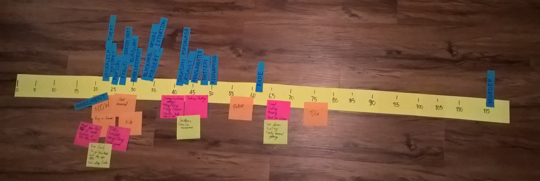If you're using your browser's reader mode, refresh the page while in reader mode to load all content.
resensitizing incarceration sentences by attaching context to numbers
a legal disconnect
The United States has a government in which citizens elect representatives to make laws on their behalf. However, that doesn’t mean the resulting law and its execution matches the desires of the people. Why? One factor is the lack of meaningful engagement between Americans and the law they have agency to shape. Through research and prototyping, I investigated how one might create better engagement.
finding an angle of approach
In order to find opportunities for improvement, I interviewed American millennials due to their tendency to be less engaged in politics. Since the research was for a course about the role of time in design, I asked them about incarceration sentences, a time-based punishment. The interviews revealed that numbers behind prison sentences were not communicative of the punishment’s consequences.
playing around with time
In response to interviewees’ thoughts, I brainstormed how one might use time to contextualize incarceration sentences. Many ideas focused on experiencing elapsed time to build empathy. I realized that a similar effect might be achieved more efficiently using a timeline.
invisible stopwatches
inspiration
Interviewees thought comparing severity of crimes to one another was a good way to determine prison sentence lengths.
activity
Participants use stopwatches that they do not look at. The participant starts and stops stopwatches in succession, with each stopwatch representing a type of criminal sentence. The elapsed time of the stopwatches are compared to one another and used as a ratio for the length of prison time for each crime.
Odysseus absence
inspiration
Interviewees hoped that lawmakers would consider was the impact of a parent's absence from the home on the family.
activity
To give context to the weight of one month in jail, participants would sever contact with someone significant to them for up to a month — if they could endure it, that is.
life timeline
inspiration
Interviewees hoped that lawmakers would consider was the perspective of the incarcerated, especially regarding missing out on life experiences in society.
activity
To visualize what one might miss out on by being sent to prison, users first create a timeline of their own life from the present day to their passing away. They then imagine that someone like them has been charged with a crime, and choose when along the timeline the person should be released based on the crime.
life timeline
I invited participants that I had not interviewed to map their lives on a timeline and then chart how long someone like them should be put in jail for various crimes.
now

major life events

ongoing activities

minor life events

sentences

First, they created a timeline of their own life with major life events from the present day to their death. Participants then listed minor experiences and weekly routines that might happen during various stages of their life. Finally, they were asked to determine a sentence lengths for various crimes for someone their age.


Despite having a timeline full of life events to reference, participants generally only considered the landmarks of retirement and death when sentencing criminals. They tended to dish out much harsher punishments than actual averages, even though they all thought they were being more lenient than the status quo.
When asked if the activity made prison sentences have increased or decreased meaning, participants stated that they felt apathetic toward the subject.
reflection
Why did participants dole out harsher punishments despite thinking they were lenient?
- The physical width of the crime markers made it difficult to place many crimes close together, causing creep toward later in the timeline.
- The timeline didn’t adequately emphasize how the incarcerated’s loved ones might be affected.
- News organizations (a source of knowledge interviewees mentioned) prioritize coverage of the worst crimes, which skews people’s expectations.
Though the prototype didn’t build much empathy, it showed that an event-based approach to representing incarceration sentences was comprehensible.